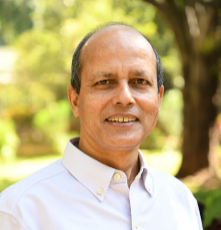PRADIP DUTTA
Indian Institute of Science, Bangalore
Modelling of Sorption based Heating and Cooling Systems
BIO
Pradip Dutta is currently Professor in the Centre for Energy Research and Associate Faculty in the Department of Mechanical Engineering at the Indian Institute of Science, Bangalore.
Currently, Prof. Dutta’s research group focuses on thermal energy storage, advanced cooling technologies, and on technologies related to phase change and adsorption.
Prof. Dutta received his undergraduate degree from IIT Kharagpur, Master’s from IIT Madras and Ph.D. from Columbia University, New York, all in Mechanical Engineering. He has been elected Fellow of ASME, ASTFE and Fellow of all the four National Academies of India in Science and Engineering. He has received Distinguished Alumnus Awards from both IIT Kharagpur and IIT Madras, J. C. Bose National Fellowship, and Outstanding Teacher Award from the Indian National Academy of Engineering. He is a former President of the Indian Society of Heat and Mass Transfer.
ABSTRACT
The basic operating principle of thermochemical energy storage (TCES) technology consists of an endothermic reaction in which surplus heat is added to separate the sorbent and the sorbate (desorption or charging process) and an exothermic reaction during which heat is released while two components are combined (sorption or discharging process). Among TCES technologies, thermochemical sorption storage systems (or sorption thermal batteries) have recently gained popularity as a viable alternative to conventional heat pumps for space heating and domestic hot water production. The sorption thermal batteries are suitable when low-grade thermal energy in the form of waste heat or non-concentrating solar thermal energy is available; they are thus ideal examples of clean energy.
In any TCES system, designing the reactor is a critical exercise as desorption, adsorption and heat exchange with the HTF all occur in this component. The reactor design should effectively address issues such as effective bed thermal resistance for adequate heat input (or removal) rate, bed permeability for adequate mass transport rate of gas/vapour (as determined by macrostructure and packing fraction, and reaction kinetics which depends on the bed pressure and temperature. All these phenomena are coupled, and this makes the reactor design extremely challenging. In this work, a systematic scaling analysis is presented first, addressing the issues of competing phenomena such as reaction kinetics, vapour flow and heat transport. Transport equations of mass, momentum and heat coupled with reaction kinetics are solved numerically using finite volume-based software ANSYS FLUENT® (version 2021 R1), employing user-defined function for appropriate source and sink terms in mass and energy equations. A chemical reaction model from literature is used to simulate hydration and dehydration kinetics. The Darcy model is adopted for flow through porous media, and thermal equilibrium is assumed between water vapour and potassium carbonate particles. The continuity and momentum equations are solved using the SIMPLEC algorithm and second-order implicit scheme for transient formulation with time steps chosen in the range of 10-4-10-3 s. A parametric study is performed to show the efficacy of the water vapour transport through the bed for varying heat exchanging domains with different aspect ratios, particle sizes and operating conditions. Results show that water vapour's heat and mass transport within the bed strongly affect the reaction kinetics occurring in fixed bed reactors. This research work provides a framework for designing the thermochemical energy storage system and optimizing the operating parameters. The dynamics of the entire system as functions of various operating parameters are presented, and the multifunctional features of the thermal battery system are demonstrated with respect to various heating and cooling applications.
